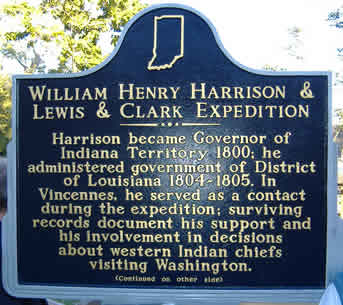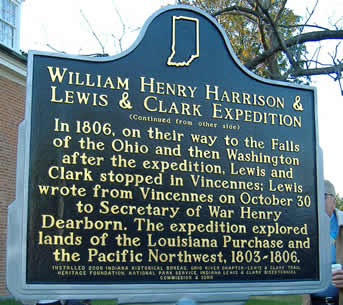

Location: Indiana Territory State Historic site, 1 W. Harrison St., near First and Harrison Streets, Vincennes. (Knox County, Indiana)
Installed: 2006 Indiana Historical Bureau, Ohio River Chapter - Lewis & Clark Trail Heritage Foundation, National Park Service, Indiana Lewis & Clark Bicentennial Commission & IDNR
ID# : 42.2006.1
Text
Side one:
Harrison became Governor of Indiana Territory 1800; he administered government of District of Louisiana 1804-1805. In Vincennes, he served as a contact during the expedition; surviving records document his support and his involvement in decisions about western Indian chiefs visiting Washington.
Side two:
In 1806, on their way to the Falls of the Ohio and then Washington after the expedition, Lewis and Clark stopped in Vincennes; Lewis wrote from Vincennes on October 30 to Secretary of War Henry Dearborn. The expedition explored lands of the Louisiana Purchase and the Pacific Northwest, 1803-1806.
Keywords
Early Settlement and Exploration, Politics, "Lewis and Clark ", American Indian/Native American
Annotated Text
Harrison(1) became Governor of Indiana Territory 1800; he administered government of District of Louisiana 1804-1805.(2) In Vincennes, he served as a contact during the expedition; surviving records document his support(3) and his involvement in decisions about western Indian chiefs visiting Washington.(4)
In 1806, on their way to the Falls of the Ohio and then Washington after the expedition, Lewis and Clark stopped in Vincennes; Lewis wrote from Vincennes on October 30 to Secretary of War Henry Dearborn.(5) The expedition explored lands of the Louisiana Purchase and the Pacific Northwest, 1803-1806.
(1)"Harrison Chronology, " Messages and Letters of William Henry Harrison, Logan Esarey, ed., (Indianapolis, 1922), 5, 6. (B00034)
1773 Feb. 9Born at Berkely Manor, near Richmond, Virginia.
1791 Oct. 3 Served as ensign in the First U. S. Regulars
1792-1794Served as aide-de-camp to General Anthony Wayne
1793 Feb. 22Became lieutenant
1797 July 10Was made captain
1798 June 1Resigned from the army
1798-1799Appointed secretary of the Northwest Territory
1799 Oct 3Elected from the territory as a delegate to Congress
1800 May 12Appointed governor of Indiana Territory
1812 Sept Took command of the Northwestern army of the United States and served during War of 1812
1813 March 3Resigned as governor of Indiana Territory
1840Elected president of the United States
1841 April 4Died in office at Washington
(2) The District of Louisiana (1804), or Territory of Louisiana (1805), included most of the land in the Louisiana Purchase north of the 33rd parallel (the present day northern boundary of the state of Louisiana). For administrative purposes, this portion of the territory was attached to the Indiana Territory. The land south of this boundary line was the "Orleans Territory." See "1803 Map of U.S. after the Louisiana Purchase, " compiled by H. George Stoll, Hammond Incorporated, 1967, revised by U. S. Geological Survey, 1970, Civics Online Web site, http://www.civics-online.org (accessed November 9, 2005). (B00592)
For acts regarding the division of the lands of the Louisiana, see U.S. Statutes at Large, II, 283-89, 331-32, Library of Congress http://memory.loc.gov/cgibin/ampage (accessed August 26, 2005). (B00594, B00595) In a letter to Harrison dated March 31, 1804, President Thomas Jefferson informs Harrison of his new responsibilities and directs him to move quickly to determine how to implement the division and governance of the lands, Messages and Letters, Esarey, ed., 94. (B00596)
John D. Barnhart and Dorothy L. Riker, Indiana to 1816: The Colonial Period (Indianapolis, 1971), 342-44, provides a good summary of the process of bringing the Louisiana Purchase under U.S. governance. (B00589)
(3)Harrison sent William Clark a copy of the "Indian Office" map that included the Missouri River and Mandan Country, acknowledged Clark's intent to keep him informed, and asked Clark to invite Meriwether Lewis to visit him in Vincennes on the way home. Harrison to Clark, Vincenes, November 13, 1803, Letters of the Lewis and Clark Expedition with Related Documents, 1783-1854, ed. Donald Jackson (Urbana, 1962), 135-36. B00600)
In April 1805, Clark sent to his brother Jonathan in Louisville three boxes of materials he gathered on the expedition, and a letter of explanation. He wrote, "3 horns of the mountain Ram all Small but one a faun those Animals inhabit Coat noir & Rockey mountains in great numbers, and much prized by the Indians (one for Govr. Harrison). . . ." William Clark to Jonathan Clark, Fort Mandan [in present day North Dakota], April, 1805, Dear Brother: Letters of William Clark to Jonathan Clark, James J. Holmberg, ed. (New Haven, Conn., 2002), 85. (B00606)
Clark wrote to Harrison from Fort Mandan in 1805. The long and detailed letter describes the country, wildlife, and Indian tribes he had encountered. Clark explained, "I do my self the pleasure of giving you a summary view of the Missouri &c [country]." Clark to Harrison, April 2, 1805, Fort Mandan, Letters, Jackson, ed., 227-30. (B00601)
(4)For Harrison's involvement in sending a group of Indian chiefs to Washington, see the following sources: Pierre Chouteau (Agent of Indian Affairs, Saint Louis) writes to Harrison regarding the Indian chiefs who had arrived in St. Louis from Fort Mandan. Chouteau asked Harrison for instructions for conducting the chiefs to Washington. There are numerous references to taking Indians to Washington to meet the "father." Pierre Chouteau to Wm. H. Harrison, St. Louis, May 22, 1805, Messages and Letters, Esarey, ed., 128-30. (B00603)
Harrison writes back to Chouteau agreeing that the Indians' trip to Washington should be postponed-if the Indian chiefs agree-until cooler weather arrives. Harrison to Pierre Chouteau, Vincennes, May 27, 1805, Messages and Letters, Esarey, ed., 135-36. (B00604)
Harrison informs the Secretary of War about the possible travel of Indian chiefs to Washington. Harrison also relays that Clark has sent him a letter [April 2, 1805] saying that all is well. William Henry Harrison to Henry Dearborn, Vincennes, May 27, 1805, Letters, Jackson, ed., 246-47. (B00606)
Chouteau indicates that some of the Indians sent by Lewis are impatient to get back to their villages and some are sick (the "Mahas" and "Poncas"). The "Ottos, " Missouris and some Sioux have gone home but will return at the end of September. Those remaining with Chouteau are the great chiefs of the "Ottos" and "Missoury, " the chief "ricaras" and some Sioux. The Indians are worried about so long a journey (to Washington) in the warm season and prefer to travel in the fall. Chouteau will prepare for that and try to get some "Sakias" and "foxes" to come. Chouteau to Harrison, St. Louis, June 12, 1805. Papers of William Henry Harrison, Clanin, ed., microfilm, reel 2, pp. 215-16. (B00607)
(5)From Saint Louis, Clark indicates to his brother that he and Lewis will be traveling together to Louisville "by the way of Vincennes." William Clark to Jonathan Clark, St. Louis. September 24, 1806, Dear Brother, Holmberg, ed. (New Haven, Conn., 2002), 115. (B00605)
A letter from Lewis to Henry Dearborn, October 30, 1806, from Vincennes, discusses Bill of Exchange number 113 to George Wallace, Jr., a merchant in Vincennes and a contractor for army rations. The original letter, mentioned in Donald Jackson's Letters of the Lewis and Clark Expedition with Related Documents, 1783-1854, p. 349. (B00608) is in the Montana Historical Society, Helena, Montana, Collection No. Sc40; photocopy of signed letter supplied to Indiana Historical Bureau by James Holmberg, Filson Historical Society. Lewis and Clark arrived at the Falls of the Ohio on, November 5, 1806., Dear Brother, Holmberg, ed., 117. (B00605)
